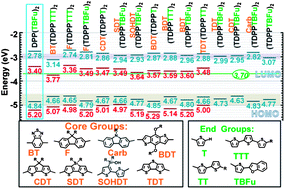We report a series of solution-processable, small-molecule, donor materials based on an architecture consisting of two diketopyrrolopyrrole (DPP) cores with different aromatic π-bridges between the DPP units and different end-capping groups. In general, this architecture leads to desirable light absorption and electronic levels for donor materials. Out of the compounds investigated, a material with a hydrolyzed dithieno(3,2-b;2′,3′-d)silole (SDT) core and 2-benzofuran (BFu) end capping groups leads to the most favorable properties for solar cells, capable of generating photocurrent up to 800 nm while producing an open-circuit voltage of over 850 mV, indicating a small loss in electrical potential compared to other bulk heterojunction systems. Device properties can be greatly improved through the use of solvent additives such as 2-chloronaphthalene and initial attempts to optimize device fabrication have resulted in power conversion efficiencies upwards of 4%.
You have access to this article
 Please wait while we load your content...
Something went wrong. Try again?
Please wait while we load your content...
Something went wrong. Try again?


 Please wait while we load your content...
Please wait while we load your content...